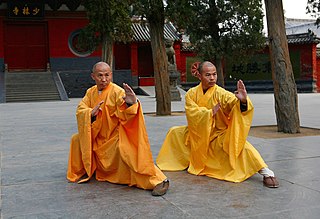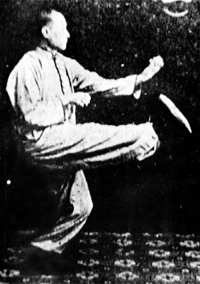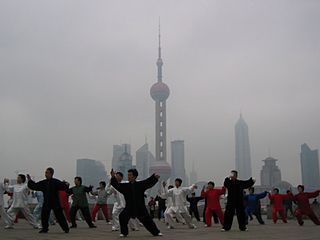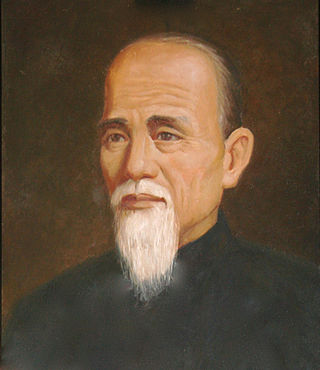
Nei jia is the collective name for the internal Chinese martial arts. It relates to those martial arts occupied with spiritual, mental or qi-related aspects, as opposed to an "external" approach focused on physiological aspects. The distinction dates to the 17th century, but its modern application is due to publications by Sun Lutang, dating to the period of 1915 to 1928. Nei jing is developed by using nei gong or "internal changes", contrasted with wài gōng or "external exercises".

Shaolin Monastery, also known as Shaolin Temple, is a renowned monastic institution recognized as the birthplace of Chan Buddhism and the cradle of Shaolin Kung Fu. It is located at the foot of Wuru Peak of the Songshan mountain range in Dengfeng County, Henan Province, China. The name reflects its location in the ancient grove of Mount Shaoshi, in the hinterland of the Songshan mountains. Mount Song occupied a prominent position among Chinese sacred mountains as early as the 1st century BC, when it was proclaimed one of the Five Holy Peaks. It is located some 48 km (30 mi) southeast of Luoyang, the former capital of the Northern Wei Dynasty (386–534), and 72 km (45 mi) southwest of Zhengzhou, the modern capital of Henan Province.

Shaolin kung fu, also called Shaolin Wushu, or Shaolin quan, is one of the oldest, largest, and most famous styles of wushu, or kung fu of Chan Buddhism. It combines Chan philosophy and martial arts and was developed in the Shaolin Temple in Henan province, Greater China during its 1500-year history. Popular sayings in Chinese folklore related to this practice include "All martial arts under heaven originated from Shaolin" and "Shaolin kung fu is the best under heaven," indicating the influence of Shaolin kung fu among martial arts. The name Shaolin is also used as a brand for the so-called external styles of kung fu. Many styles in southern and northern China use the name Shaolin.

Eagle Claw is a style of Chinese martial arts known for its gripping techniques, system of joint locks, takedowns, and pressure point strikes, which is representative of Chinese grappling known as Chin Na. The style is normally attributed to the famous patriotic Song dynasty General Yue Fei. Popular legends states that he learned martial arts from a Shaolin Monk named Zhou Tong and later created Eagle Claw to help his armies combat the invading armies of the Jin dynasty. It was passed down until the Ming dynasty. Thus, the style took on long range strikes and aerial jumps. During the Qing dynasty, the military instructor Liu Shi Jun became known as the modern progenitor of Eagle Claw and taught many students. His student Liu Cheng You later taught Chen Zizheng who was invited to teach the style in the prestigious Chin Woo Athletic Association during the Republican era. The style spread as Chin Woo opened sister schools in other provinces. Today, it is practiced around the world.

Vajrapāṇi is one of the earliest-appearing bodhisattvas in Mahayana Buddhism. He is the protector and guide of Gautama Buddha and rose to symbolize the Buddha's power.
The Venerable Chi Sin Sim Si is a legendary Chinese martial artist, said to have been one of the Five Elders, survivors of the destruction of the Shaolin Temple by the Qing Dynasty (1644–1912). He is linked to many southern Chinese martial arts including the five major family styles of Hung, Lau and Choy gar, Lee gar and Mok gar, Ng Ga Kuen/Ng Gar King and Wing Chun.

Bak Mei is said to have been one of the legendary Five Elders—survivors of the destruction of the Shaolin Monastery by the Qing dynasty (1644–1912)—who, according to some accounts, betrayed Shaolin to the imperial government. He shares his name with the South Chinese martial art attributed to him.

In its broadest sense, Northern Shaolin is the external martial arts of Northern China, referring to those styles from the Northern Shaolin Monastery in Henan and specifically to the style practice by Gù Rǔzhāng, the Sōngshān Shí Lù Shàolínquán (嵩山十路少林拳) / Song Mountain Ten Road Shaolin Boxing.
In Southern Chinese folklore, the Five Elders of Shaolin, also known as the Five Generals are the survivors of one of the destructions of the Shaolin temple by the Qing Dynasty, variously said to have taken place in 1647 or in 1732.

Huaquan is a style of Long Fist Kung Fu (Changquan) which is believed to have originated in the Former Song dynasty around the Hua Shan area of Shaanxi Province.

There are hundreds of different styles of Chinese martial arts, each with their own sets of techniques and ideas. The various movements in kung fu, most of which are imitations of the fighting styles of animals, are initiated from one to five basic foot positions: normal upright posture and the four stances called dragon, frog, horse riding, and snake. The concept of martial arts styles appeared from around the Ming dynasty (1368–1644). Before the Ming period, martial skills were commonly differentiated mainly by their lineage. There are common themes among these styles which allow them to be grouped according to generalized "families", "fractions", "class", or "schools" of martial art styles. There are styles that mimic movements from animals, or otherwise refer or allude to animals or mythical beings such as dragons, and others that gather inspiration from various Chinese philosophies or mythologies. Some deeply internal styles tend to focus strongly on practice relating to harnessing of qi energy, while some more-conspicuously external styles tend more to display skills and abilities in competition or exhibition.

Yu Dayou (1503–1579), courtesy name Zhifu, art name Xujiang, was a Chinese general and martial artist best known for countering the wokou pirates along China's southeastern coast during the reign of the Jiajing Emperor in the Ming dynasty.

Although the earliest evidence of martial arts goes back millennia, the true roots are difficult to reconstruct. Inherent patterns of human aggression which inspire practice of mock combat and optimization of serious close combat as cultural universals are doubtlessly inherited from the pre-human stage and were made into an "art" from the earliest emergence of that concept. Indeed, many universals of martial art are fixed by the specifics of human physiology and not dependent on a specific tradition or era.

Chan Heung was the founder of the Choy Li Fut martial arts system.

Meir Shahar is the Shaul Eisenberg Chair for East Asian Affairs at Tel Aviv University.

Tang Hao or Tang Fan Sheng (1887–1959) was a Chinese lawyer and expert on chinese martial arts.

Wudangquan is a class of Chinese martial arts. In contemporary China, Chinese martial arts styles are generally classified into two major groups: Wudang (Wutang), named after the Wudang Mountains; and Shaolin, named after the Shaolin Monastery. Whereas Shaolin includes many martial art styles, Wudangquan includes only a few arts that use the focused mind to control the body. This typically encompasses tai chi, xingyiquan and baguazhang, but must also include bajiquan and Wudang Sword. Although the name Wudang simply distinguishes the skills, theories and applications of the internal arts from those of the Shaolin styles, it misleadingly suggests these arts originated at the Wudang Mountains. The name Wudang comes from a popular Chinese legend that incorrectly purports the genesis of tai chi and Wudang Sword by an immortal, Taoist hermit named Zhang Sanfeng who lived in the monasteries of Wudang Mountain.
The Southern Shaolin Monastery or Nan-Shaolin (南少林) is the name of a Buddhist monastery whose existence and location are both disputed although associated ruins have been identified. By tradition, it is considered a source of Nanquan.

Drunken boxing also known as Drunken Fist, is a general name for all styles of Chinese martial arts that imitate the movements of a drunk person. It is an ancient style and its origins are mainly traced back to the Buddhist and Daoist religious communities. The Buddhist style is related to the Shaolin temple while the Daoist style is based on the Daoist tale of the drunken Eight Immortals. Zui quan has the most unusual body movements among all styles of Chinese martial arts. Hitting, grappling, locking, dodging, feinting, ground and aerial fighting and all other sophisticated methods of combat are incorporated.

The Shaolin Monastery Stele is a tablet inscribed front and back to obtain two faces of continuous text in Chinese characters. The total engravable surface is about 10 m2 (110 sq ft). The name was in use by later scholars studying the Tang dynasty (618-907), who understood the tablet to be an important primary source on early Tang dynasty events. It is being presented by many writers of the current times as the first source indicating that the professedly pacific monks did in fact participate in dynastic wars.














